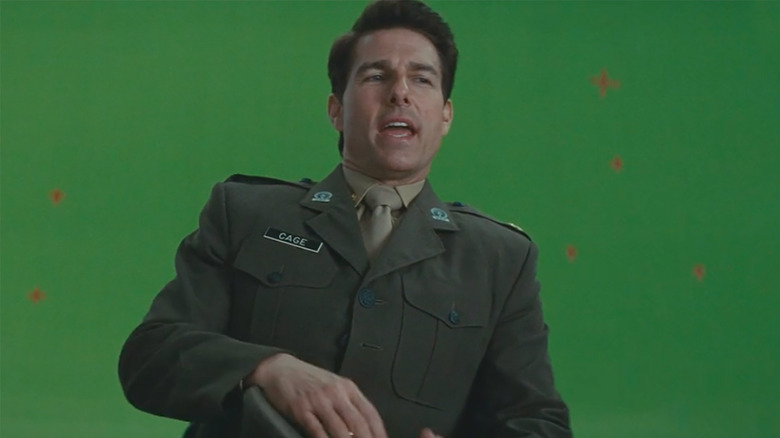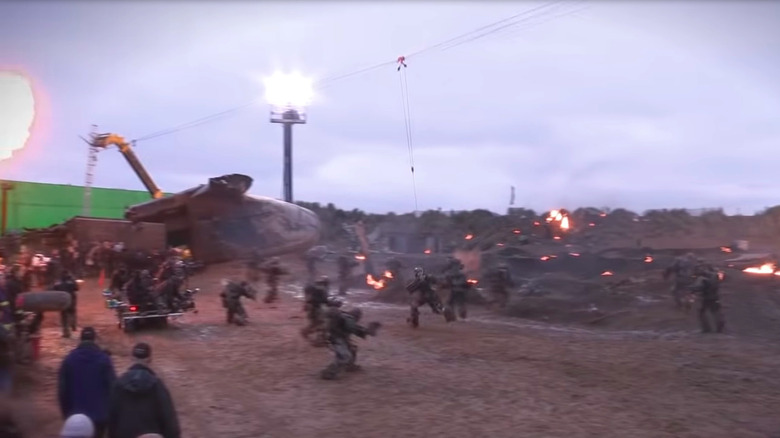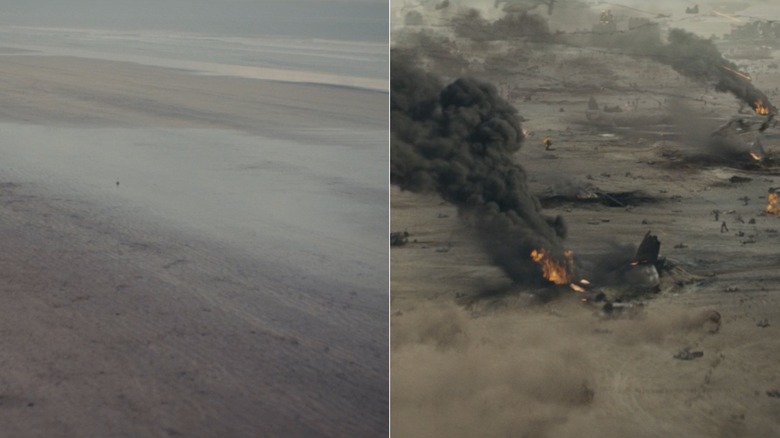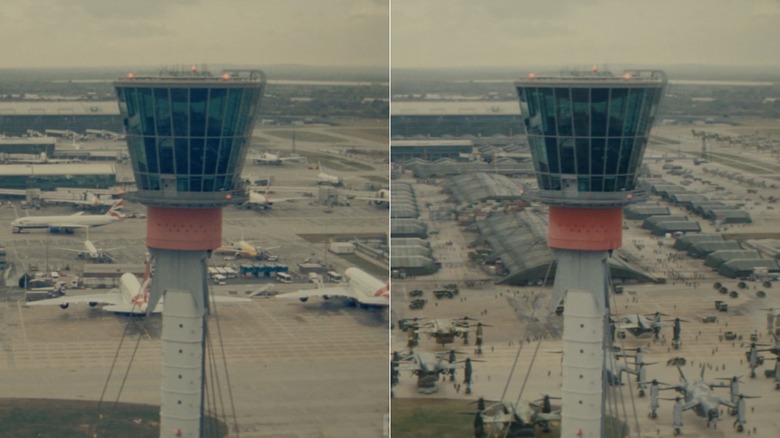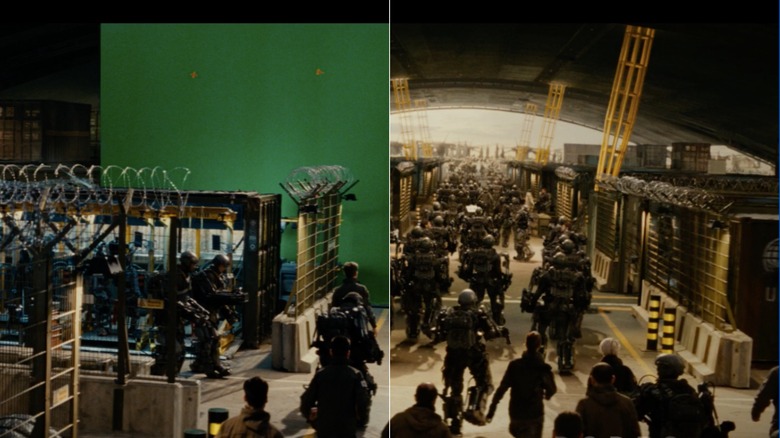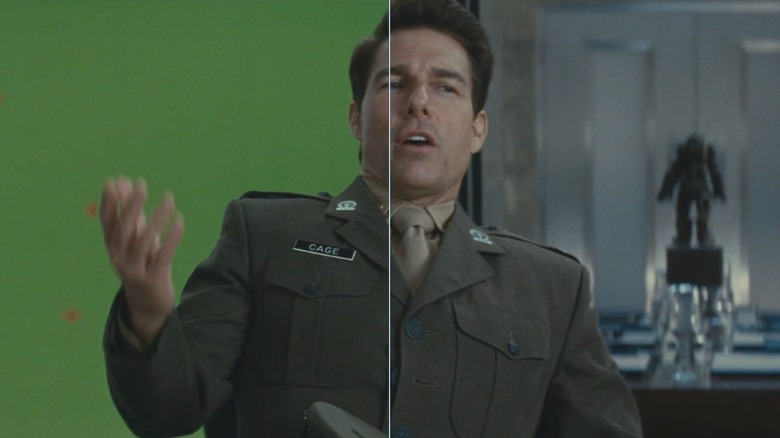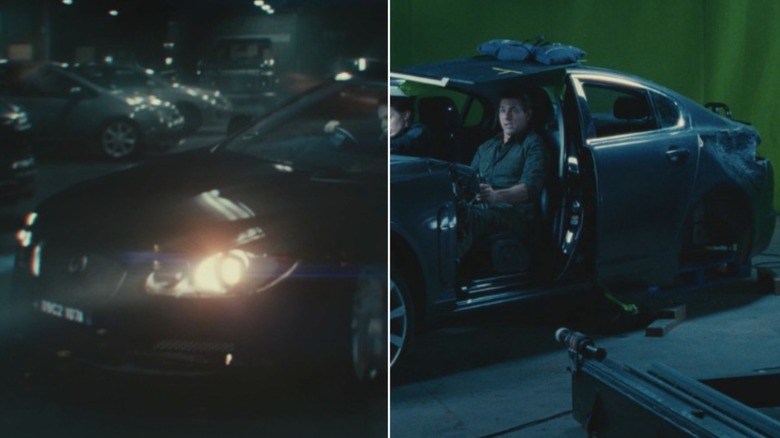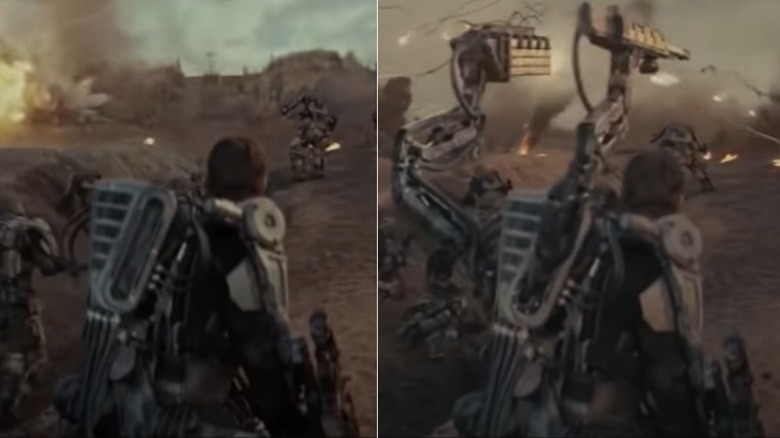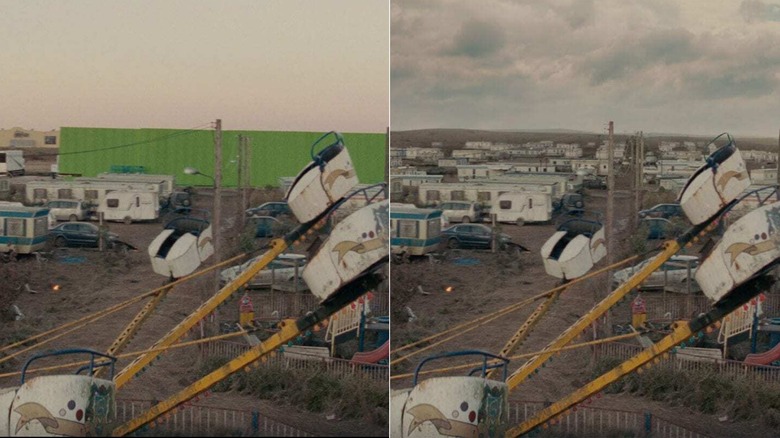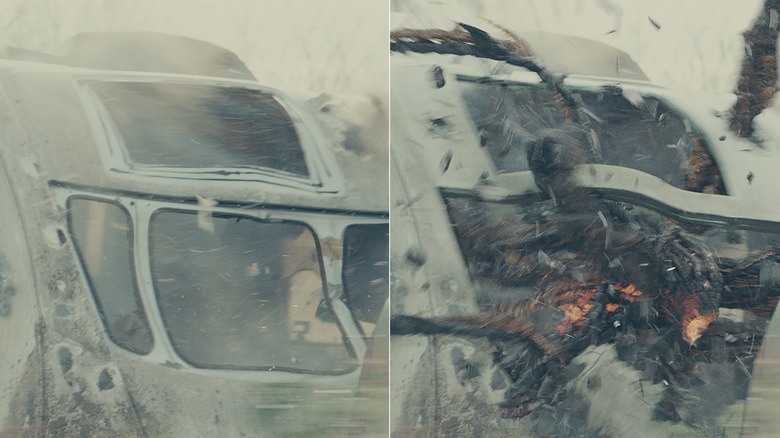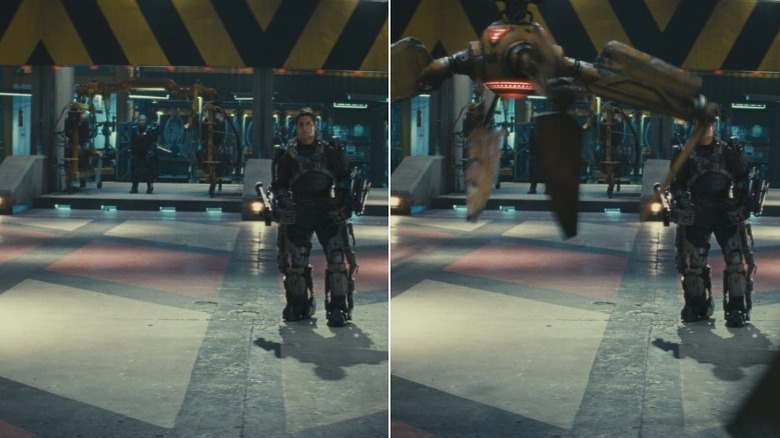What Edge Of Tomorrow Looks Like Before Special Effects
Sci-fi actioner "Edge of Tomorrow" mashed up the repeating time loop of the classic "Groundhog Day" with the World War II epic "The Longest Day," wherein Private Cage (Tom Cruise) repeatedly relives and dies in a doomed military operation against unstoppable alien creatures called Mimics. The film delivers a relentless barrage of action and twists as Cage learns from his experiences and becomes a better man as a result. The film's tagline, "Live Die Repeat," could just as well have been "Saving Private Cage."
Like most blockbusters, "Edge of Tomorrow" demanded a meticulous fusion of practical and visual effects to depict this near-future world in all its gritty grandeur. What's surprising is where effects were employed and for what purposes. Watching the film, you know the Mimics are visual effects, because how could they not be. But you have no clue that shots of actors walking through a military base are just them walking away from a greenscreen. And while more than a decade of superheroes sporting digital costumes might suggest this film's exo-suits were entirely CGI effects, the reality is something else.
So strap into your Jacket, grab an extra battery, and get ready to reset the past of "Edge of Tomorrow" and its cinematic magic to see what it looked like without special effects.
Fly by wire
In an age of CGI costumes tracked onto actors, "Edge of Tomorrow" took an old school approach by actually building the exo-suits, known as "Jackets," worn by the troops. In-story, these suits are powered by some high-tech batteries that grant superhuman abilities. In reality, the actors' muscles powered them. With an average weight of 85–90 pounds (38-40 kg), and the biggest ones heavier by a third, this was no easy feat. Between scenes, Jacketed cast members would hang from overhead chains to give themselves a break.
Not all of the Jackets were quite so heavy. One suit worn by stunt performer Liang Yang — doubling for Emily Blunt — was primarily made from rubber, with plate armor made of foam, no doubt to make stunts easier and prevent injury. It's likely other background and stunt suits had similar construction.
Whatever version of the Jackets was employed, their mass and bulk hindered those wearing them from performing tasks like running (as pictured), scrambling, or standing up quickly. In these cases, the suits would rely on overhead cables to bear much of the weight, allowing wearers to run and jump. Digital wire removal erased all traces of such support systems, but they're visible in behind-the-scenes photos and footage. Even in the finished film, in some shots, the troops supported by these rigs sometimes experienced difficulty keeping their feet on the ground.
War's a beach
Most of the production of "Edge of Tomorrow" occurred at Warner Bros. Leavesden Studios in England, where the crew built nearly 50 sets. Location shooting was limited, with most taking place at London's Ministry of Defence, Trafalgar Square, and Westminster Bridge, as well as a disused army camp at Barton Stacey.
However, the film's pivotal action setpiece, portraying Project Downfall's massive troop landing in France, wasn't on a beach or anywhere near the sea at all. Location scouts found several candidate beaches, but the realities of tides, weather, logistics, and the complexities of the overhead wire rigs necessary for the Jackets ruled out a real seaside location. Instead, the production constructed its own beach on the studio backlot, measuring 300 feet to a side, using 1,300 tons of sand littered with wreckage, all backed by 1,800 feet of greenscreen.
Despite relying on VFX from Sony Imageworks to achieve the necessary scope, the production did not rely on them for everything. Air cannons blasted walls of sand into the air, and practical pyrotechnic effects generated huge fireballs for the cast to react to.
Beachfront property
Many times, the best visual effects are those that incorporate real-world photographic elements. In "Edge of Tomorrow," many of the aerial settings could have been achieved entirely with CGI, but the decision was made to build on actual landscapes and existing human-made elements. A prime example is evident in Operation Downfall. Although staged in the controlled environment of the studio backlot, one of the real beaches scouted as a possible location was used to produce plate photography for digitally constructing the battlefield.
Saunton Sands, on the north coast of Devon, was considered as a shooting location due to its resemblance to the French coastline. Aerial shots were taken from a helicopter to serve as the base element onto which CGI elements from Rodeo FX were layered and to provide textures for digital set extensions for the studio-bound "beach."
To obtain these aerial shots, the beach remained unaltered. No set dressing was applied, no performers ran across the sand in Jackets, and no fires or explosions were set off. It was captured in its natural state. All the blast craters, troops, bodies, Mimics, vehicles, aircraft, debris, explosions, smoke, and dust were modeled, rendered, and composited onto these pristine plates, as the before and after images demonstrate.
Airport overhaul
In one of many World War II parallels, Britain stands almost alone against an enemy that has overrun much of Europe. As in wars throughout history, the military has commandeered facilities and infrastructure. London's Heathrow airport, due to its proximity to the mainland, has been transformed into a forward base from which UDF forces deploy in their ill-fated invasion, and to which Cage resets each time he dies.
However, filming at a working airport like Heathrow would have been impractical and prohibitively expensive. Therefore, the production sent a unit to capture footage that could be reworked by Rodeo FX to transform the bustling civilian airport into a forward military base. The tarmac was covered with tents, temporary structures, military vehicles, slightly futuristic drop-ship transports, and gunships.
Yet, obtaining the necessary footage wasn't straightforward. Despite being an airport, Heathrow is not a heliport and is a designated helicopter no-fly zone. The production had to secure a special exception to the rules to fly a helicopter into Heathrow's airspace and approach the control tower. The results were worth the effort, as the base is convincingly realized.
Heathrow barracks
With Heathrow ruled out as a filming location, the solution was to recreate the fictional base using indoor and outdoor sets at Leavesden Studios. This necessitated constructing numerous practical sets and partial sets, most of which were later extended and enhanced by Rodeo FX. These sets were then visually linked to the real airport using photographic plates shot on location for backgrounds.
One of the most impressive set extensions at the simulated Heathrow is the structure housing J-Squad, where Cage repeatedly meets its members to increasingly humorous effect. The physical set was initially limited in both dimensions and the number of actors and background artists present. However, both aspects were significantly expanded through effects work. The set was extended into the distance to reveal the open end and the tarmac beyond, while the number of troops was multiplied many times over using digital figures. These CGI soldiers were created from scans of performers in UDF uniforms, various national uniforms, and all members of J-Squad. Some were even placed in CGI Jackets to fill out the ranks and create masses of troops both at Heathrow and during the Operation Downfall landing.
Into the ordinary VFX
Despite the growing backlash against "CGI" and the increasingly preposterous studio claims about blockbuster films being entirely practical and eschewing CGI, movies have always thrived on illusion. Effects are almost as old as the medium itself. The difference between a matte painting or a hanging miniature and digital effects is that they're all just different forms of fakery. As Denmark-based Visual Effects Supervisor Jonas Ussing articulates in his excellent video essay series, "'NO CGI' is really just INVISIBLE CGI" "Matte paintings are to Alfred Hitchcock what lens flares are to JJ Abrams."
But why the reliance on effects instead of going entirely practical? Sets are costly to build, and the larger the set, the higher the expense. Moreover, once constructed, it requires ongoing funds to leave them standing, unused, and occupying soundstage space, just in case reshoots are necessary. For these reasons, effects are often utilized for mundane real-world environments. Even when practical sets are built, they are extensively photographed and LIDAR scanned so that virtual versions can be employed long after the set has been demolished.
Consider the film's opening scene, set in the office of General Brigham (Brendan Gleeson), where Cage receives the orders that he later refuses, setting the plot into motion. In close-ups, Tom Cruise appears to be in an actual office or set, but Cinesite's "Edge of Tomorrow" VFX breakdown reel reveals he's just sitting in front of a greenscreen.
Autobody experience
The time-loop element means that the majority of the film's screen time is dedicated to two main locales: the UDF's Heathrow forward base and its facilities, and the Normandy beach. Consequently, the majority of vehicles depicted are of the military variety, while the few automobiles and vans we see are mostly abandoned.
A notable exception to this pattern occurs in London, where traffic still flows, and Cage rides a motorcycle ... because he's played by Tom Cruise. Most of the automobiles seen are in the garage of the UDF headquarters at Whitehall, and in the brief street scene following, where Vrataski and Cage come to a crashing halt against a Jacketed soldier.
The garage sequence is replete with obvious visual effects, such as the streaky slo-mo as Cage's eyes turn black and he experiences a vision. However, less obvious is that the entire garage and the automobile driven by Vrataski are CGI, as revealed by Cinesite. Blunt and Cruise were filmed in an actual automobile, albeit one with parts removed to keep the actors in shot during camera moves. Subsequently, a fully digital car was match-moved to this footage and composited over the real one. Finally, the entire scene was dropped into a fully CGI garage populated with parked CGI vehicles.
Angel wings and things
While practical, the mass and movement limitations of the Jackets also impacted the armaments they carried. Even when stowed, the backpack mounted guns added weight, and making them deploy, aim, and fire would require complicated and expensive props. So the decision was made to add such weapons digitally.
For example, Vratasky's "Angel Wings" railguns attached to her Jacket's back weren't present on the costume. Orange tracking markers allowed VFX artists to match move CGI versions of those weapons onto the Jackets, and, of course, animate them deploying and firing. The same was true of the back-mounted weapons of all the practical jackets.
There were exceptions, or course, Some of the Jackets had prop devices built onto them, as seen on some of the heavy-duty "Tank" variants of the type worn by Kimmel (Tony Way) and others, but when necessary even these physical props were digitally erased and replaced by more mobile CGI versions (via Cinesite). Production effects supervisor Nick Davis told Cinefex (via Film School Rejects), "They built practical ones for us to scan and photograph, but they never got used in the movie. They were always digital."
Trailer park
After countless failed attempts to escape the beach in their pursuit of the Omega Mimic, Vrataski and Cage finally manage to flee the killing field and reach an abandoned trailer park. Cage reveals they've been here numerous times before as they search for a working vehicle to travel inland.
Like the beach, the trailer park was constructed on the Leavesden backlot, making it a prime candidate for being a largely digital environment, given its single appearance. However, numerous trailers and vehicles were placed on the set, including a lightweight auto shell for Tom Cruise to swat aside with his Jacket as Cage.
To enhance the location's authenticity, the set was extended by Rodeo FX using digital effects to illustrate its proximity to the beach and quadruple the size of the trailer park. The actual trailers were photographed, and their surfaces were used to texture the fully digital trailers used to expand the setting. Even the sky was altered to better match what was seen on the beach.
Trailer trashed
Throughout the film, the Mimics are entirely visual effects. Their design and the terrifying speeds at which they move made it impossible to depict them practically. After extensive concepting, the filmmakers found inspiration for these creatures in Esteban Diácono's "Ex Machina," his entry to a project called "Resonance," which he says "explores the behavior of a pure, simple geometrical piece that grows and evolves violently, affecting its surroundings."
Designing these creatures is one thing, but making them convincing in context with physical sets is another challenge altogether. Key to placing them into live-action environments is ensuring they interact seamlessly with their surroundings.
A prime example of this is when kick-ass Rita Vrataski (Emily Blunt) and Cage escape the trailer park. The van they have commandeered tows a small trailer, from which a Mimic drone erupts. Cage dispatches it with his Jacket's weaponry. Similar to the car in the garage, all the live action was shot on stage against greenscreens, with the trailer rigged with nitrogen cannons to jolt it upwards as the Mimic begins its attack. On set, the trailer was rigged to deform and distort as the non-present Mimic tears through its front. This practical effects work was then enhanced by Rodeo FX with the addition of the Mimic and a digital replacement of parts of the trailer that would specifically move and tear based on the Mimic's actions.
A terrific presentation
One of the more memorable supporting characters in the film is Dr. Carter (Noah Taylor), a former researcher in Whitehall who has been discredited and sent to Heathrow's armory to work as a mechanic on Jackets. In a side room there, he has cobbled together a computer with a holographic display he uses to explain Mimic biology to Cage via "a terrific presentation."
As with many other locations in the film, the armory sets were fairly limited. To save money, only about a third of the briefly-seen main room filled with Jackets and mechanics was built, repurposing elements from other sets. It was then extended digitally (via Cinesite). This effect remains seamless even with a sweeping camera move.
When Carter activates the holograms of the Mimics, it's obvious that we're looking at visual effects, but what's not obvious is how much of the shot is effects work. However, a VFX breakdown video by Prime Focus demonstrates that in some cases, the entire room surrounding our heroes is also artificial.
Reboot camp
One large interior at Heathrow is the training arena, where Cage meets kick-ass Vrataski and undergoes rigorous training against mechanical Mimic simulators. Here, he repeatedly experiences death while striving to transform into a human fighting machine capable of matching Vrataski on their desperate mission to kill the Omega Mimic, the only means to halt the horrific invasion.
Certain parts of this set were practical, while others were CGI models based on LIDAR scans of the physical set elements. However, the focal point of this set is the beat-up, industrial mechanical Mimics and their spinning, slashing blades. On set, Tom Cruise navigated an empty arena (via Cinesite), reacting to human-guided poles indicating the positions of these whirling dervishes, while air cannon blasts provided stimuli for his reactions.
Special effects also facilitated the seamless transition from shots of Cruise in his Jacket costume to a CGI double capable of enduring the abuse Cage experiences, sometimes resulting in his demise. Cruise often performed the action up to the point where Cage is hit and thrown into the air, after which a digital double would execute stunts that could have resulted in serious injury. Tom Cruise might look immortal, but, as far as we know, there's no "reboot" option for him.
In the end, Cage had an endless number of second chances, but will the movie? Will there ever be a second installment? Unfortunately, no one who's lived the future has reset to today to tell us... yet.
If you're jonesing for another "Edge of Tomorrow fix, check out the deleted scenes, which include a CGI previs!
